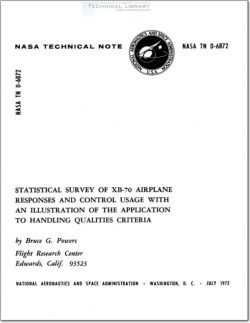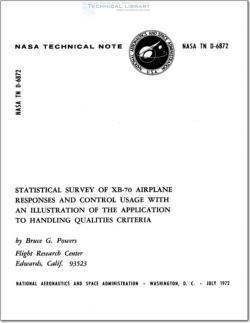NASA-TN-D-6872

- Version
- 204 Downloads
- 1.28 MB File Size
- 1 File Count
- June 16, 2016 Create Date
- June 16, 2016 Last Updated
Statistical Survey of XB-70 Airplane Responses and Control Usage with an Illustration of the Application to Handling Qualities Criteria

In the preliminary design of aircraft, several assumptions have to be made re-
garding the maneuvering capability that must be provided in various parts of the
flight envelope. On the basis of these assumptions, the size and authority of the con-
trol surfaces can be determined. The assumptions are generally extrapolated from
aircraft experience such as that described in references 1 to 4. However, little quan-
titative information is available, especially in terms of frequency of usage of airplane
response and control inputs, which could be applied to large, supersonic cruise
vehicles.
The purpose of this study was to determine the magnitude and frequency of occur—
rence of XB-70 airplane responses and control inputs. Results are presented for the
normal operation of the airplane, as well as results of specialized tests (such as
stability and control). These tests were made to indicate mission and flight test re—
quirements.
Flights were divided into six regions for analysis. The data were limited by the
number of flights (27) and by the sampling rate of 1 point per minute, which yielded
less than 3000 data points for each parameter. As a result, the data were limited to
frequencies of occurrence greater than 10' . A separate analysis was made of the
final approach and landing region for 17 flights for which data were sampled at a rate
of 20 points per second.
Examples are given of the use of statistical data of this type to establish or verify
handling qualities criteria. Two methods are used to establish the relationship between
the probability of exceeding a response and the handling qualities criteria boundaries.
The XB—70-1 is a large, delta-wing airplane designed for Mach 3 cruise. For this
study the gross weight ranged from approximately 227, 000 kilograms (500, 000 pounds)
at takeoff to about 136, 000 kilograms (300, 000 pounds) at landing. A three—View draw—
ing of the airplane is shown in figure 1. Movable wing tips were used to improve high—
speed directional stability. They were undeflected at low speeds, deflected 25° at
transonic speeds, and deflected 65° at supersonic speeds. Flaps on the canard were
used during takeoff and landing.
Longitudinal control was provided through the elevons and canard, except that when
the flaps were down the canard was locked. Lateral control was provided through the
differential operation of the elevons and directional control through the two vertical
stabilizers. Stability augmentation was provided in the pitch, roll, and yaw axes and,
except for special tests, was generally operating during the entire flight. Trim was
normally put in through the augmentation system. A more detailed description of the
XB-70 airplane is presented in references 6 and 7.
| File | Action |
|---|---|
| NASA-TN-D-6872 Statistical Survey of XB-70 Airplane Responses and Control Usage with an Illustration of the Application to Handling Qualities Criteria.pdf | Download |

Comment On This Post